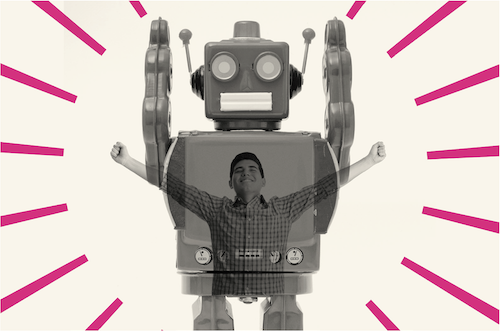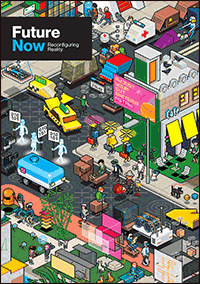Future Now
The IFTF Blog
Your New Telepresence Superpowers
Get ready for your robotic upgrade
 Thuc Vu, CEO and Co-founder of the Silicon Valley startup OhmniLabs, says his favorite thing to do with a telepresence robot is to cook with his grandmother. She is teaching him how to prepare Vietnamese dishes he enjoyed as a child. He lives in the United States while she lives in Vietnam, but with the Ohmni robot that his company makes, “It’s the closest thing to being there in person without physically being there.” The 35-year-old entrepreneur says that from his house in California he steers the Segway-shaped robot, which sports a large display screen, around his grandmother’s kitchen. There he can “poke my camera into the different ingredients, pots, and pans and ask her questions.” His grandmother can pour, mix, and add ingredients hands free, without holding a phone or tablet to talk to him, “so it becomes much more of a rich, engaging interaction versus just sitting in front of Skype.” With the growing popularity of telepresence robots, the telecommunication network is evolving into a “teleaction” network. Meaning long-distance communication is moving beyond a merely verbal or textual conversation (phone, email, text) into the broader communicative realm of shared experiences. And with lighter weight, less expensive robots coming onto the market, we can expect to see more telepresence robots not only in corporate, government, and academic institutions, but also in private homes.
Thuc Vu, CEO and Co-founder of the Silicon Valley startup OhmniLabs, says his favorite thing to do with a telepresence robot is to cook with his grandmother. She is teaching him how to prepare Vietnamese dishes he enjoyed as a child. He lives in the United States while she lives in Vietnam, but with the Ohmni robot that his company makes, “It’s the closest thing to being there in person without physically being there.” The 35-year-old entrepreneur says that from his house in California he steers the Segway-shaped robot, which sports a large display screen, around his grandmother’s kitchen. There he can “poke my camera into the different ingredients, pots, and pans and ask her questions.” His grandmother can pour, mix, and add ingredients hands free, without holding a phone or tablet to talk to him, “so it becomes much more of a rich, engaging interaction versus just sitting in front of Skype.” With the growing popularity of telepresence robots, the telecommunication network is evolving into a “teleaction” network. Meaning long-distance communication is moving beyond a merely verbal or textual conversation (phone, email, text) into the broader communicative realm of shared experiences. And with lighter weight, less expensive robots coming onto the market, we can expect to see more telepresence robots not only in corporate, government, and academic institutions, but also in private homes.
Currently, telepresence robots are still in their infancy. Yes, an out-of-town mother can play hide-and-seek with her daughter at home, a physical therapist can show her long-distance dad how to do stretches for his strained back, and a person can save a life by calling 9-1-1 after virtually checking in on an older relative and finding him unconscious (real examples). But these robots are limited. They have wheels instead of legs, so stairs are a problem, and they don’t have arms, so doing chores, pushing an elevator button, or simply waving hello is out of the question. However, telepresence robots are quickly evolving with more human-like capabilities that will enable a richer experience for everyone involved. Here are three examples of robotic upgrades we can expect to see in the near future:
1. See and Hear Like a Superhero
Right now a tutor beaming into a student’s house might strain her eyes to read the algebra worksheet. And an employee beaming into the office might have trouble hearing what the boss is saying if the office is competing with outside noise. But Suitable Technologies, who makes the telepresence Beam Robot in Palo Alto, CA, launched some prototypes this year with improvements to both hearing and vision.
“We have a telepresence robot that’ll have super senses,” says Bo Preising, the company’s Chief Strategy and Product Officer. Preising says these audio and visual “super senses” should be on the market in the next year or two.

One improvement will include their pan-tilt-zoom camera, which allows the robot’s head to move up and down to match the eye level of those around it. “The pan-tilt-zoom is like your eyeball,” says Preising. “If your head is stationary, you can move your eyes around … and then the extra feature, which human vision doesn’t really do so well, is … you can zoom in on something far across the room, like 20 feet away, and actually be able to read a business card.” Imagine how helpful supervision will be for someone looking at documents at a virtual business meeting, or a long-distance caregiver looking at lesions on a patient’s skin.
Robots will also have a better audio system with noise cancellation so that people can hear with more clarity. “We have an array of microphones that can get rid of all the extra noise in the room,” says Preising. “If you imagine yourself in a situation where you’ve got a jackhammer outside of the house, our microphones can delete that noise so you’ll be able to hear what’s going on in the room better than people who are actually in the room.” As for people actually in the room, they will be able to hear the person driving the robot with more clarity than anything currently on the market.
2. Pick Up Faraway Objects
Arms for telepresence robots are already a reality, but they’re not available to consumers—yet. Suitable Technologies has robotic arms at the company that can manipulate objects and pick things up off the floor. But, according to Preising, “They are still very expensive for most people,” and the user interface is still a bit challenging.
To accelerate the development and affordability of the arm, OhmniLabs has invited developers from around the world to brainstorm with them as part of an open-source community collaboration. “The ability to pick up an object is a key capability we are working on,” says Vu. “We are working on a lightweight but also affordable and highly capable arm to allow the robot to pick up and manipulate objects in the real world.” Vu says that it’s absolutely possible to achieve this in five years.
3. Chip in With Housework, Rosie the Robot Style
There’s an episode of The Jetson’s in which Rosie, the robot maid, lights up a cigar for Mr. Spacely (George’s boss) with a lighter that is built right into her hand. That’s the idea behind robots that can do chores. OhmniLabs is brainstorming about ways to build a robot that can vacuum, clean the dishes, and do laundry.
Thinking outside the box, Vu says that rather than have the robot use its “hand” to pick up a tool such as a scrub brush, the robot would have built-in (or attachable) tools. “Instead of having the robot pick up a vacuum cleaner and move it around the home, we can build the vacuum right into the robot, in the base.”
So if your college kid runs out of the house after leaving a pile of dishes in the sink, you’ll be able to tell him to march right over to his laptop or smartphone and clean up his mess. And maybe you can even hang out with him in the kitchen while he’s at it.
While Priesing pragmatically says this is something that might be available in 15-30 years, Vu says that he could see a housekeeping telepresence robot, like the robotic arm, ready in five years.
 FUTURE NOW—Reconfiguring Reality
FUTURE NOW—Reconfiguring Reality
This third volume of Future Now, IFTF's print magazine powered by our Future 50 Partnership, is a maker's guide to the Internet of Actions. Use this issue with its companion map and card game to anticipate possibilities, create opportunities, ward off challenges, and begin acting to reconfigure reality today.
About IFTF's Future 50 Partnership
Every successful strategy begins with an insight about the future and every organization needs the capacity to anticipate the future. The Future 50 is a side-by-side relationship with Institute for the Future: a partnership focused on strategic foresight on a ten-year time horizon. With 50 years of futures research in society, technology, health, the economy, and the environment, we have the perspectives, signals, and tools to make sense of the emerging future.
For More Information
For more information on IFTF's Future 50 Partnership and Tech Futures Lab, contact:
Sean Ness | sness@iftf.org | 650.233.9517



